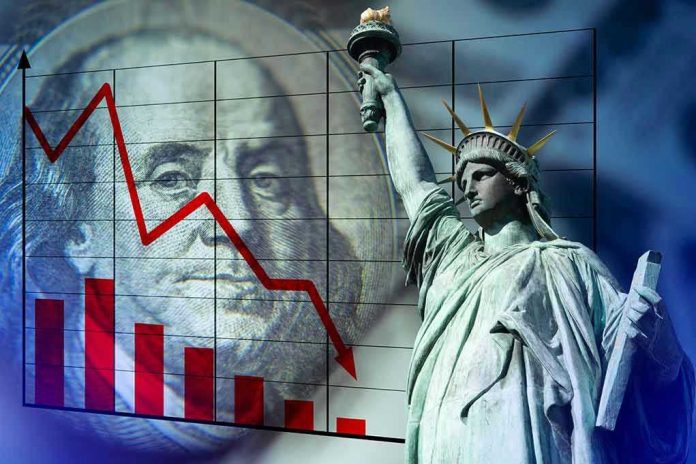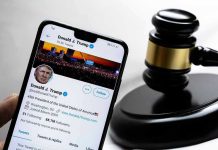
Wall Street’s shocking new reality: not even the dollar or U.S. government bonds can be counted on as safe havens when presidential power collides with central bank independence.
Story Highlights
- Dow plunges nearly 1,000 points and Nasdaq reels as Trump renews attacks on Fed Chair Jerome Powell
- Equities, the dollar, and Treasuries all fall together, upending traditional market safety nets
- Trump’s demands for immediate rate cuts deepen investor anxiety and question Fed independence
- Global investors reevaluate U.S. asset exposure, signaling a shift in confidence and strategy
When the Market’s Compass Breaks: A Historic Sell-Off
The Dow Jones Industrial Average lost almost 1,000 points in a single day, and the Nasdaq Composite shed 2.6%, with 92% of S&P 500 stocks declining. Tech giants Tesla and Nvidia led the drop, but the shock was broader—U.S. government bonds and the dollar also tumbled, an unmistakable signal that investors were not just fleeing stocks but the financial foundation of the United States itself. This rare convergence left Wall Street scrambling for new safe havens, with gold suddenly gleaming as the preferred refuge. All eyes were on the White House and the Federal Reserve as the usual rules of market stability seemed to vanish.
Trump’s public rebuke of Fed Chair Jerome Powell wasn’t just political theater; it sent shockwaves through every trading floor. By demanding immediate interest rate cuts and blaming Powell for economic risks, Trump ignited doubts about the Fed’s independence—a cornerstone of global financial stability. Investors, already jittery from ongoing trade war escalations, found themselves confronting a crisis of confidence. The simultaneous collapse of equities, bonds, and the dollar forced a global reassessment: could the United States still serve as the world’s anchor for capital?
Political Power and Market Panic: The Fed Under Fire
Presidential pressure on the Federal Reserve has historical roots, but the frequency and public nature of Trump’s attacks marked a radical departure from modern norms. The executive branch and central bank have always maintained a delicate balance, but Trump’s rhetoric threatened to upend that equilibrium. By calling out Powell and demanding policy concessions, Trump brought political risk to the very heart of U.S. monetary policy. Investors responded by pricing in not just economic risk, but the possibility of institutional breakdown—an outcome that could ripple through every corner of the global economy.
Wall Street responded with swift, visible distress. As BlackRock strategists observed, the old playbook for risk management no longer applied; long-term assumptions about U.S. stability and safe-haven flows suddenly seemed dangerously outdated. The sell-off was not limited to American assets. International investors, sovereign wealth funds, and pension managers began shifting their allocations, searching for safety in less volatile markets and alternative currencies.
Global Repercussions and Shifting Strategies
The fallout from the Dow’s plunge reverberated well beyond U.S. borders. The erosion of confidence in traditional American safe havens forced global investors to reconsider their strategies. The dollar’s drop increased import costs and reduced international purchasing power, while rising gold prices signaled a move toward tangible assets. Meanwhile, major corporations like Tesla and Nvidia faced not only macroeconomic headwinds but also company-specific risks as earnings season intensified scrutiny.
Financial analysts and economists warned that undermining central bank independence could have far-reaching consequences: higher inflation, reduced economic stability, and the loss of America’s privileged place in global finance. The immediate impact was wealth destruction for investors and heightened risk for corporations. Longer term, persistent doubts about U.S. policy stability threatened to increase borrowing costs and reduce capital inflows, with direct effects on growth and employment.
Expert Perspectives and Fact-Checked Realities
Industry experts at BlackRock and major financial news outlets consistently highlighted the unusual simultaneous decline of equities and traditional safe havens as a warning sign of systemic risk. Economists emphasized that while presidents have pressured the Fed before, never had it been so public and persistent, raising red flags about institutional credibility. The broader industry—from financial services to technology to manufacturing—faced a reckoning with new risk paradigms and shifting global supply chains.
Amid the turmoil, viral social media posts alleged that Trump called for his own impeachment over the market drop. Fact-checkers at PolitiFact, Snopes, and AFP swiftly debunked these claims, reminding investors and the public that misinformation spreads fastest when nerves are frayed and stakes are highest. Reliable sources, including AP and CNBC, provided clarity on the actual statements and market data, cutting through the rumor mill to deliver facts.
Sources:
PolitiFact: No, Trump didn’t post that the president should be impeached over market drops
Virginia Business: The Dow sinks 1,000 points









